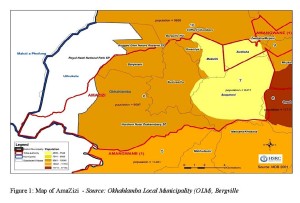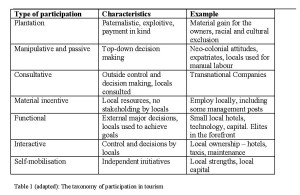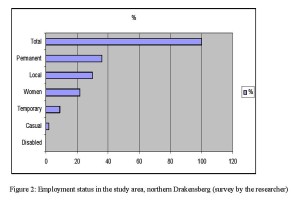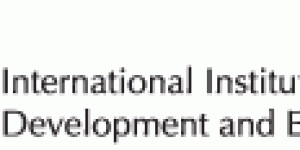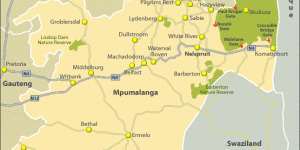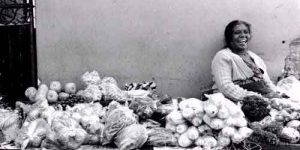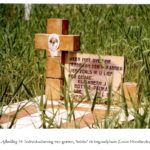IIDE Proceedings 2011 ~ Vol.I ~ People And Parks: Pro-Poor Tourism And Small Enterprise Development In The Northern Drakensberg, Kwazulu-Natal, South Africa
No comments yetIntroduction and background to nature conservation in South Africa
This chapter provides a critical analysis of the economic opportunities and barriers found around the conservation area of the Royal Natal National Park in the northern Drakensberg. The chapter argues that the park and the tourism industry present avenues for viable opportunities for the poor to engage in entrepreneurial practices at levels commensurate with their capital assets in order to reduce poverty and unemployment. However, the extent to which the poor access certain assets depends on a number of factors such as their own knowledge and attitudes, as well as the role of the institutions that govern the daily conduct of people’s lives.
Under the eras of colonialism and apartheid in South Africa, protected areas were largely proclaimed at the expense of the African populations that were forced to make way for them — sometimes with promises of economic benefits. This became the era of fences and fines against those forced out. The protected areas became the preserve of the privileged white minority to the exclusion of the black majority (Child 2004; White Paper 1994; Nkosi and Abbot 2002).
The history of conservation in South Africa is therefore characterised, among other things, by dispossession, exclusion, suppression, deprivation and marginalisation. Because of the racial character of past (conservation) policies, a foundation was laid for contestation, instead of beneficiation, between the parks and local communities, as well as for a sense of loss and poverty within those communities. Conservation areas became a “white man’s space”, as evidenced by the Kruger National Park (Honey 1999:340-344), despite the issuing of promises of economic benefits to the local communities, as the people were forcefully removed from some of these areas (Ramutsindela 2004:108; Bell 1997:95). To this day in South Africa, communities adjacent to conservation areas are largely characterised by mass poverty, unemployment and dependence on natural resources. Besides the low-skills jobs available to them, the selling of handicrafts in the informal sector represents the main form of entrepreneurial participation in tourism – as is the case among the AmaZizi of the northern Drakensberg in KwaZulu-Natal, on whom this article is based.
In the democratic dispensation, the South African government (in the White Paper on the Development and Promotion of Tourism 1996) promotes tourism as one of the routes to job creation and sustainable development. The White Paper states that tourism in South Africa has the potential to generate R40 billion per year and create no less than two million jobs. Nature conservation authorities such as the KZN Ezemvelo Wildlife have also responded to the challenges through the introduction of a community levy where part of the income from the conservation areas is made available to the adjacent communities. Though the concept of the community levy is laudable, it may create unhealthy dependency on the conservation areas by the local communities. It is in this regard that alternatives such as entrepreneurship development are considered. But again, is it possible to identify specific sectors and means by which tourism benefits can be maximised in order to contribute to poverty reduction and unemployment, especially among the AmaZizi in the northern Drakensberg?
The constitutional requirement for South African municipalities to adopt a developmental character and the requirement to implement policies of local economic development, for example, create the necessary institutional framework to provide the poor with opportunities to engage in entrepreneurial activities without necessarily competing with established business.
Conservation areas have begun allowing local people opportunities for self-employment. Within the areas under the control of KZN Ezemvelo Wildlife, new developments have taken place lately. At the Didima Camp and Royal Natal National Park local people are allowed to operate a camp site and to provide security services, respectively. These efforts represent the positive impact that tourism can have on the lives of the people adjacent to conservation areas. In many other conservation areas, as a result of land restitution in particular, conservation areas have entered into partnerships with the formerly excluded black communities. Examples are found of partnerships between the Kruger National Park and the Makuleke community, the Manyaleti Game Reserve and several adjacent communities, as well as the Madikwe Game Reserve and the local people. The partnerships include land leases and the sharing of revenue from activities such as hunting. The Spier Leisure resort in Stellenbosch has gone a step further to procure goods and services from the local people (Ashley and Hayom 2008:134).
Background to the area under study
Geographically, the area of AmaZizi is situated approximately 46 km from the rural town of Bergville in KwaZulu-Natal, South Africa.[1] The town, surrounded by white-owned commercial farms producing mostly maize, is situated on the banks of the Uthukela (Tugela) River, with its source inside the Royal Natal National Park (RNNP). AmaZizi lies at 28.44°S and 29.32°E adjacent to the beautiful Royal Natal National Park, southwest of Bergville and at the foot of the Drakensberg. The area falls under the Uthukela District and the Okhahlamba Local Municipality. The provincial map (Figure 1) shows the municipalities. The area of AmaZizi (AmaZizi Tribal Authority) falls under wards 6 and 7, as indicated in Figure 1. The area varies between 1 402m and 2 743m above sea level.
Ecologically – soil type, climate, altitude, terrain and vegetation – the study area shows great homogeneity. It is this kind of uniformity that enables one to speak of the northern Drakensberg. Generally speaking, the northern Drakensberg is characterised by a moderately restricted growing season as a result of its low temperatures and severe frost in winter. However, it has the potential for good yields over a range of adapted crops, despite the short growing period. Only 43.85% of the soil is suitable for commercial farming, as the soils are shallow and drainage is poor. In addition, 40.3% of the even and gently sloping areas are too rocky and 19.5% are too steep for farming. This leaves less than 5.2% as arable land. Crops that have a good potential to grow in this area are maize, potatoes, soya beans, cabbages and carrots. The vegetation consists primarily of grassland and very isolated areas of forests. It is a summer rainfall region, with an annual mean of 1 198mm rainfall and 13.7 ºC temperature.
Historically, the people of AmaZizi are an integral part of the broader South African society. As a people and also as a geographic area the AmaZizi have experienced both the good life and the harsh realities that all South Africans, especially Africans, have faced through the ages. The story of the AmaZizi is told by Pearse (1989:26-39) in his book entitled Barrier of the spears: drama of the Drakensberg. These people once lived a life of peace and harmony among themselves and with their neighbours and nature. Their children were raised to value the virtues of personal cleanliness and respect, among other things. They led a very relaxed life, a fact which, as Pearse states, led to their own demise.
Since their settlement at the feet of the magnificent Ukhahlamba (Drakensberg) Mountains in the early 1200s (Pearse 1989:26), they have been the victims of various regimes. During the period of what is usually referred to as the imfecane in South African history, the people of AmaZizi suffered greatly as they fought and lost against other Nguni tribes (Pearse 1989:33). At one stage they were forced to live in caves, as their “enemies” destroyed their crops and livestock while trying to force them to surrender. This made it possible for them to live with the San people, who occupied the greater part of the Ukhahlamba mountains. They learnt to hunt and gather food just as the San people did, and intermarriages took place between the two tribes (Pearse 1989:27). When their enemies retreated, the AmaZizi returned to rebuild their shattered lives.
For a long time the AmaZizi lived under the Ukhahlamba Mountains, growing crops and grazing livestock without limits, except for the fact that they avoided encroaching on the land of their neighbours of AmaNgwane until the arrival of white people in the area. Once again, the newcomers were bent on occupying the land that the AmaZizi considered to be theirs. This came to symbolise what turned into decades of the political and economic subjugation of indigenous peoples, not only in the AmaZizi, but in South Africa in general.
It was in 1884 that the whole area of the northern Drakensberg was finally surveyed. Farms, state land and the so-called native reserves were demarcated. The Royal Natal National Park itself was proclaimed on 19 September 1916, covering, among other areas, the magnificent amphitheatre, Mount-Aux-Sources and The Glen. Today the Park covers an area of 7 400 ha. The name includes the word “royal” as the British royal family stayed there for a short time in 1947 (Pearse 1989:134,141).
Empowerment through participation in tourism
This article is not necessarily about setting up the poor in the business of providing tourism services as such. Instead it mainly considers other opportunities that may be regarded as externalities as well as auxiliary (referring to the indirect and induced employment opportunities discussed below) to the core functions of the tourism industry. This stance is adopted primarily because the argument here is that the poor should be able to participate in the economy as entrepreneurs, using their own limited capital assets. In this case,
Timothy (2004:151-152) explains that participation in tourism could range from the level of exploitive practices to a level of self-mobilisation. This article attempts to place the rural poor at the functional level through to the level of self-mobilisation as shown in Table 1.
Once a community takes an active, meaningful role in the local economy, it could gain strength and be empowered in many ways. Timothy (2004:152) shows that such empowerment comes in the forms of (1) economic benefits which accrue to the local communities, (2) psychological benefits as locals gain status, self-esteem and confidence through economic empowerment, (3) social cohesion attained as communities collaborate in their efforts to improve their condition, and (4) improved political participation as local people realise that they have a stake in the manner in which decisions are made and begin to lobby for policy changes. It is under such conditions that development can be said to be happening. In Sen’s (1992) language, this could represent a situation where people begin to claim their freedoms.
Types of employment opportunities resulting from tourism
Cukier (2004:167) identifies various forms of employment opportunities that are usually generated by tourism:
– Direct employment. This refers to employment opportunities that are a direct result of tourism establishments such as working in hotels, restaurants and tour companies.
– Indirect employment. This kind of employment refers to economic activities that are dependent on the existence of tourism such as construction, and various professions (e.g. doctors serving tourists).
– Induced employment. The existence of tourism can induce the emergence of other economic activities that would otherwise not have emerged. These activities would stem from spin-offs from tourism.
Direct employment is the most common benefit of tourism that accrues to local people as they obtain employment opportunities – permanent, temporary, seasonal and so on. This kind of employment tends to be very limited in terms of local people making decisions and participating as owners of local resources on which tourism depends. It can be identified as “plantation” in terms of Table 1. Tourism does not stand alone as an economic activity. It also depends on many other economic activities. It is by participating in those other economic activities that the poor can make an impact through small enterprise development – induced employment.
Why small and medium enterprises (SMEs)?
Small and medium enterprises can make significant contributions to the reduction of poverty and unemployment in the northern Drakensberg. According to Timothy (2004:157), small enterprises have improved benefits for the local populace. These benefits include increased control over local resources including land, reduced economic leakages, and reduced dependency on outsiders. In terms of Table 1, local people would participate interactively. Although tourism has always provided local communities with individual employment opportunities, these have been unsustainable and lacking in long-term benefits. There are specific advantages to establishing small enterprises which could be explained in the following manner (Hardwick, Khan and Langmead 1990:144-147; Hall and Jenkins 1995:47-60):
(a) Economies of scale
Enterprises have specific advantages over individuals trading in the informal sector along the roads for example. A firm is more likely to produce at higher levels than an individual. Because a firm’s production activities are repetitive in many cases, labour gets to specialise and therefore to improve in terms of technical skills. Better skills translate into a better product/ service in the industry. The growth of small enterprises presents opportunities for employment opportunities and therefore could greatly strengthen South Africa’s attempts at the reduction of poverty and unemployment. According to the Centre for Development and Enterprise (CDE), no less than 45% of South Africa’s workforce is employed in small businesses, and at the international level this figure rises to 60% (CDE 2004: 17).
(b) Access to capital
Unlike individuals in the informal sector, firms tend to have better chances of raising financial capital. In a situation such as rural South Africa, where ordinary people either have little or no wages, collateral becomes an issue when loans are to be made, as banks insist on collateral. It is therefore hoped that small businesses may be able to raise funding for their operations.
(c) Spreading market risks
A small enterprise stands a chance of diversifying its activities in various market segments within the tourism industry. There is nothing stopping a small business from engaging in agri-business and at the same time being involved in waste collection, for example. In that manner the risk of doing business is spread over different activities while the opportunities presented by both indirect and induced employment in the tourism industry are exploited.
(d) The power of organised business
Small enterprises stand a good chance of even influencing local policy-making if they are themselves organised into an interest group. For example, local governments in South Africa are struggling to make their local economic development plans functional in rural areas because the poor have very little to contribute. This factor contributes in turn to slow or prevent development in many rural areas. With reference to Table 1, local people stand a chance to achieve interactive participation or even to achieve self-mobilisation.
(e) Improved communications
Many rural areas are characterised by poor communication channels or a complete lack of communication channels such as road infrastructure and transport. The development of small business could lead to improving such conditions. Without proper communications – roads, transport – it is difficult to access markets. Improved communications would therefore play a vital role in adding economic value to the less developed areas in rural South Africa.
(f) Levelling the playing field
Mayoux (2003:4,7,8) points out that small enterprises help the rural poor in particular to cope with the harsh economic environments which are the outcome of globalisation, structural adjustments and liberalisation, for instance. Because they are labour-intensive, SMEs increase the levels of employment and provide skills and experience that would otherwise be unavailable. Small enterprises could also help to reduce class and gender inequalities as marginalised groups are afforded monetary incomes.
The role of institutions in the fight against poverty
In explaining the attempts to reduce poverty and unemployment, institutions are identified as a determining factor. Institutions determine what assets are available to the people and how people access those capital assets. Such institutions are defined as the rules, norms and strategies which shape individual and organisational behaviour (High, Pelling and Nemes 2008:3); as rules or sets of rules that structure social interaction by shaping and constraining actors’ behaviour (Helmke and Levitsky 2004:30); as the humanly devised constraints that shape human interaction (Boesen 2006:2); as laws, legislation and policies (DFID 2007); as systems of established and prevalent social rules that structure social interaction (Hodgson 2006:2); and as complexes of norms and behaviours that persist over time by serving some socially valued purposes (Narayan 2000:8). Bradstock (2005: 12) notes that ‘while assets are a necessary condition for poverty reduction, they are not sufficient alone. A favourable institutional environment that allows households to use their assets to the greatest potential is also necessary.’
To this effect, organisations (structures) play a critical role in determining how and with what assets people pursue their livelihoods through the application of various forms of policies (institutions). Such institutions either have a facilitative role or become barriers to the realisation of goals by individuals and groups. In Sen’s (1999) terminology, institutions and organisations could either represent “unfreedoms” that prohibit people from enhancing their capabilities and realising the lives that they value, or they could represent progress. Magubane (2007:21) observes that institutions and structures can also be used to “insure that those described as inferior and dispensable have less access to the resources of their countries …” The argument is that if institutions and structures can be successfully used to denigrate and impoverish a people, as happened in colonial and apartheid South Africa, it should not be difficult to use institutions to raise the people from the ashes and pit holes of poverty.
Today, South Africa is caught between two paradigms: that of neo-liberalism at the national level, and an interventionist paradigm at the local level. The country’s macroeconomic strategy of GEAR, for example, suffered from relying on the trickle-down syndrome; it had very little effect if any poverty reduction. It espoused policies that favoured big business and was more concerned with export economies. At the municipal level, interventionist developmental policies were promoted irrespective of the fact that the majority of the municipalities are poor. On the other hand, the land policies in rural and urban areas vary greatly, to the disadvantage of rural people. These are fundamentals that the country must face if it wishes to address poverty and unemployment in a more meaningful manner. The two-paradigm approach makes it difficult to pursue any single policy holistically.
To this end, McGrath and Akoojee (2007:422-427) indicate that the shortcomings in GEAR were addressed by the introduction of the policies of Accelerated and Shared Growth Initiatives for South Africa and the Joint Initiative for Priority Skills Acquisition in 2005. These policies were aimed at halving unemployment and poverty, accelerating employment equity and improving the skills base as well as the performance of black economic empowerment policies. The GEAR policy itself had come about as a result of the shift from the Reconstruction and Development Programme (the RDP), which was more directed to grassroots development. It must be pointed out here that there is no formal statement of that paradigm shift. However, it is not difficult to realise that the RDP was not going to be pursued while at the same time the country had committed itself to neo-liberal policies which advocate reduced state spending. The RDP as a grassroots programme required very active state involvement in the economy. To this end, GEAR and the RDP represented two varying development paradigms that were not compatible with the developmental needs of a country like South Africa, which is still characterised by massive structural socioeconomic inequalities.
Although the South African economy shows signs of growth, unemployment and poverty levels continue to rise. Once again, the government has introduced a new macroeconomic policy called The New Growth Path (NGP) (Zuma 2011, State of the Nation Address). The policy is targeted at creating what the President referred to as decent jobs and improving the skills base of the country’s population. Specific sectors that the NGP will focus on are the infrastructure, agriculture, mining, the green economy, manufacturing and tourism. In all of these cases the objective will include taking advantage of the value chains involved. The extent to which the NGP will succeed remains to be seen.
With the national Constitution designating local municipalities as developmental local governments in South Africa, pro-poor tourism (PPT) stands a chance of greatly benefiting from proposed policies such as the Local Economic Development policy, Integrated Development Plans, expanded public works programmes, small, medium and micro enterprises, land policies, and broad-based black economic empowerment (Abrahams 2003; Bond and Khosa 1999:31-47). All of these policies are aimed at ensuring that the poor and the previously disadvantaged and marginalised groups in South Africa are at least afforded the opportunities to participate meaningfully in the country’s economy. The policies are also intended to assist emerging businesses to grow to a competitive level. Having said this, we need to guard against assuming that a community (individually or as households) will automatically be able to engage in business simply because the policies are supportive. The capital assets that a community possesses will in the final analysis determine what outcomes the policies have. In this regard, state intervention becomes even more crucial, particularly at local level. Abrahams (2003:187-188) defines local economic development as ‘the process of creating wealth through the organised mobilisation of human, physical, financial, capital and natural resources in locality … to produce higher standards of living, improve the quality of life, alleviate poverty, create more and better jobs, advance skills and build capacity for sustained development in the future.’
In the South African context, local governments are constitutionally entrusted with the task of ensuring that economic development happens in their areas. The Municipal Systems Act of 2000 requires that all municipalities in South Africa undertake an Integrated Development Plan (an IDP). The IDPs have legal status and supersede all other plans that guide development at local government level. Chapter Seven of the Constitution (Act 108 of 1996) stipulates the functions of the developmental local government. To this effect, the South African government adopted the policy of Local Economic Development (LED) as one of the key performance areas for municipalities and developed a framework for its implementation – the National Framework for LED in South Africa.
The Integrated Development Plan is conceptualised as a tool to assist municipalities to achieve their development mandates (DPLG 2000). In South Africa, Integrated Development Planning is defined as ‘a participatory approach to integrate economic, sectoral, spatial, social, institutional, environmental and fiscal strategies in order to support the optimal allocation of scarce resources between sectors and geographical areas and across the population in a manner that provides sustainable growth, equity and the empowerment of the poor and the marginalised.’ (DPLG 2000:15)
The South African type of public works programme (EPWP) was introduced in 2004 after the Presidential State of the Nation Address by the former State President Thabo Mbeki in 2003. Public works programmes usually entail spending on infrastructure development. The South African experience is that this spending was designed in such a way that some government departments are required to make plans and implement them to help fight poverty and unemployment rather than having the Department of Public Works do this alone. The programme was expanded to cover at least four economic sectors, namely the infrastructure sector, the environment and culture sector, the social sector and the economic sector. The EPWP aims to contribute to redressing the legacy of apartheid by reducing inequalities, unemployment and the racially skewed skills system. It will do this by providing poor, unemployed women and youth in particular with short-term jobs (lasting no more than four months) where they will be trained in a variety of skills categories as well as in the formation of Small, Micro and Medium Enterprises , and also to further the aims and objectives of the Broad-Based Black Economic Empowerment (BBBEE) (Altman and Hemson 2007:8,10; McGrath and Akoojee 2007:422; McCord 2005:566,567).
In the BBBEE and EPWP South Africa has tools not only to address the structural problems of income poverty and the skills shortage but also to pursue small enterprise development by concentrating on expanding into small, medium and micro enterprises. The emphasis needs to shift from the provision of short-term jobs through the poverty relief projects within conservation areas to the establishment of small enterprises by local people. This is not to claim that the EPWP does not consider small enterprises. It does. But to many of the poor, the EPWP is simply a mechanism to provide the poor with short-term jobs.
Economic potential in the northern Drakensberg
Figure 2 that represents people employed in all categories – permanent, women, temporary, casual and disabled – shows the employment status in the northern Drakensberg. Of the total number of employed people, 36% were employed on a permanent basis, only 30% were locals, 22% women, 9% were employed on temporary basis, 2% as casual workers, and none of the surveyed businesses employed disabled people.
As can be seen in Figure 2, the local tourism industry employed very few of the local people. This, as well as the fact that so few of them participated as entrepreneurs in tourism, explains the existence of mass poverty and unemployment in the area.
A survey conducted by the author in the northern Drakensberg pointed to positive attitudes towards the involvement of local people in tourism. As already stated above, the idea is not to get local people into the exercise of providing accommodation, for example. Their assets may not be adequate for such an exercise. Sanitation, for example, is extremely poor. Instead, the survey looked at those areas that local people could participate in using their existing capital assets. The survey therefore tells what and how the local people may meaningfully take part in tourism, using the assets at their disposal.
To begin with, the tourism industry in the northern Drakensberg indicated opportunities for the involvement of the adjacent community. 75% of the surveyed businesses indicated that they were in fact willing to outsource and or buy goods and services from the local people. At the same time 62.5% of the business respondents indicated that they had some of their activities outsourced though not to local people. 12.5% thought that the local people lacked the necessary skills to do business. Business indicated that the services that could be outsourced (or purchased from) to local people were laundry services, some food supplies, tour guiding, construction, cleaning and transportation.
Local procurement: Opportunities for the local people in the tourism industry
Based on the results of the survey and the author’s observations of the area, it emerged that the area of AmaZizi as well as the tourism industry possessed great potential for the local people to benefit as entrepreneurs. On the other hand, the four focus group interviews that were conducted with the people of AmaZizi never revealed their understanding of the fact that the tourism industry could present business opportunities for them besides wage employment. This point will become clearer when, below, we address barriers to successful entrepreneurship by members of the local community. Here, the idea is to entrepreneurially exploit the spin-offs of the tourism industry.
Waste collection
Waste, or rubbish, is not always a bad thing. Particularly in urban areas, many people derive their livelihoods from “scavenging” from dump sites and related areas. Municipalities have as a result developed policies to ensure that such people do this kind of work in some ordered and legal way by encouraging the establishment of SMMEs, and in some cases residents’ cooperatives in solid waste disposal (Grierson and Brown 2000:297-300 and Snel 2000:305-308). In this regard, waste constitutes an externality that the tourism industry may have no use for. But for the purposes of pro-poor tourism, waste from the hospitality industry may provide sustainable sources of income for some of the rural poor. In the northern Drakensberg young children are a common sight at a dump site, where they scavenge for leftovers of whatever kind.
Waste from this industry can be used in different ways. Some of the ways include the recycling of items such as tins, bottles and paper. Local people could benefit from collecting these items and selling them to recycling companies or could start their own recycling businesses. Some of this waste could be useful in the making of handicrafts as well. Items such as spoilt foodstuffs and leftovers could be biodegraded into garden compost which could be used as fertiliser in the production of agricultural supplies that local people could produce. This is not participation in tourism in the sense of providing labour or a tourism service; rather it is meaningful participation by providing an auxiliary service to those who provide core tourism services. In other words, it is exploitation of the tourism spin-offs based on one’s own capital assets.
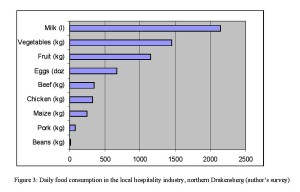
Figure 3: Daily food consumption in the local hospitality industry, northern Drakensberg (author’s survey)
Agricultural supplies to the tourism industry
Figure 3 indicates the amounts of food consumed in the local hospitality industry on a daily basis. The figure serves to show only the size of the market that the local people could capture if they ventured into supplying the industry with agricultural produce. The items of produce shown were chosen particularly on the basis that the local people do already produce these in large quantities, mainly for own household consumption; but they also sell the surplus among themselves, although that is not the primary purpose of production. In the northern Drakensberg the tourism businesses buy the same supplies from Pietermaritzburg and Ladysmith, thus creating sizeable economic leakages from the area. In this case the people of AmaZizi could be using their land – a critical asset – to create profitable employment for themselves and substantially alleviate their poverty.
The data captured in Figure 3 were obtained from 53.8% of the hospitality houses in the northern Drakensberg. As can be seen from the above figure, milk, vegetables, fruit, eggs, beef and chicken have high levels of consumption and the local people have the potential to produce these foodstuffs and supply the industry. It was found during the research period that the local community could easily produce vegetables and eggs for the industry. Generally the northern Drakensberg is characterised by a moderately restricted growing season as a result of its low temperatures and severe frost in winter. Nevertheless, it has the potential to produce good yields over a range of adapted crops – especially if techniques such as covered growing are considered. Crops that have a good potential to grow in this summer rainfall region, with an annual mean of 1 198 mm and 13.7 ºC of rainfall and temperature, are maize, potatoes, soybeans, cabbage and carrots (Cedara 2008). The local community is therefore at some advantage here. They can successfully participate in the tourism industry as suppliers of agricultural products.
Products such as eggs, bread, milk, handicrafts, entertainment, maize and vegetables could be easily obtainable from the local communities. However, 12.5% of business respondents pointed to the land tenure system as not lending itself to the productive use of resources – especially of the land which is communally owned and remains uncultivated at certain times of the year, mainly in winter. They therefore doubted that local communities could sustainably supply the tourism industry with agricultural products throughout the year. They also pointed out that there were specific conditions under which they could be willing to do business with these communities. The conditions were
– a good price
– a good quality
– a regular supply
– acceptable hygienic standards
– no involvement of labour unions
– no involvement of tribal authorities
While the conditions with regard to the quality of the goods and services supplied are related to good business practice, the last two conditions pose problems. Businesses in this region were very conservative. Some of their ideas reflected the thinking espoused by the apartheid regime such as the “communist threat”, which the hoteliers mentioned at every turn of the discussion in spite of the evidence that South Africa has a democratic Constitution that is very specific on issues. Trade unions were seen as being unreasonable when it came to wage negotiations. The hoteliers saw trade unions as being bad for business.
With regard to the tribal leadership, some hoteliers saw them as “a bunch of useless people that lived at the expense of others”. The poverty among local people was largely blamed on the tribal system, which failed to inculcate modern economic values. These respondents felt that local people could not do anything without first seeking approval from the local chief. They therefore felt that it could be very difficult to do business in a situation where the other party could not make independent decisions. Here, Philp’s (2009:19) observation that the South African government had failed to see traditional leaders as having blocked development in their areas through their control over land becomes clearer.
While agricultural production requires sizeable pieces of land, the production of chickens and eggs can take place on relatively limited space, including in the homesteads. Again, many local people kept fowls for their own consumption and only a few were involved in raising them for sale. Still, none were selling the product to the local tourism industry. Such efforts needed only to be expanded and markets created in order for the local people to realise their potential in the first economy.
Transport
Locally owned taxis are the only form of public transport available to the people of AmaZizi. The business community was of the view that the local people who owned the taxis could take an active role in transporting the tourists around the area – especially since local people are likely to know the places better than outsiders. Local people trained in tour guiding could for example give tourists the kind of information that may not in fact be written down anywhere. A taxi owner or driver could serve not only as a transporter but also as a tour guide. Some basic form of training in tour guiding may therefore be a great advantage to those interested in participating as entrepreneurs in the tourism industry.
One area of concern was the tendency of the black taxi industry to be involved in violent conflict. One respondent hotelier expressed very grave concern about that situation. He pointed out that although the taxi industry stood to benefit greatly from tourism, it was at the same time likely to impact negatively on the tourism industry, which could be severely affected by violence, thus forcing tourists to go to other places.
However, it is important to take into consideration the South African government’s efforts to introduce measures aimed at stabilising the black taxi industry. Some of the measures include taxi recapitalisation whereby the industry is required to use better, roadworthy taxis to cater for people with different physical needs. The other measure is to get taxi drivers into some form of training to educate them on how to work with their customers. Having said this, it cannot be disputed that the South African taxi industry will need a lot of planning and organising before it can be a reliable partner in the tourism industry.
Laundry and cleaning
One accusation generally levelled against tourism is that local people are employed in low-paying menial jobs, and that women in particular tend to be given domestic work with few prospects of advancement. This kind of work is done by local people employed at a fixed wage. Cleaning, washing and ironing are some of the jobs that local women do as ways of earning their livelihood. The point here is that such tasks could easily be outsourced to these very women. Laundry and ironing could easily be undertaken by local residents, especially since the area of AmaZizi has electricity.
Construction and plumbing
In the northern Drakensberg, the tourism industry makes use of local labour in the construction of houses. This is one skill that is freely available among the local people. The problem is the manner in which that skill is utilised. The workers are generally employed by the establishments who own the construction development. The idea is that these builders should instead be independent contractors who provide a service to the industry. They should be able to sign contracts and employ their own labour. In that way, the economic scales would be more balanced.
Childminding
Many visitors to the tourism areas bring young children with them. Since children cannot always accompany their parents on tourist outings or activities, there may be an opportunity for local people to earn a livelihood as childminders while the parents enjoy themselves in the mountains, for example. Such a service could also lead to an increased number of visitors to the area as the visitors would find that bringing young children along would not limit their freedom to explore the area. Such a service could be easily included in the advertising brochures.
Value chain
It is not possible to specify all of the possible enterprises that could be formed in and around tourism in a particular locality. However, there is no doubt that all economic activities have a value chain consisting of the supply, production and distribution of goods or services. Each stage or level has other enterprises – technical support, technology, money – that operate in it and create its own value chain, in turn waiting to be exploited. That value chain alone could present important opportunities for the local people of AmaZizi.
Barriers to participation in the formal tourism economy
According to business principles, whoever wishes to engage in business should meet four basic requirements: financial capital (money), human capital (skill/knowledge/training), natural capital (land) and physical capital (machinery). So the question should be: do the people adjacent to conservation areas possess these requirements and or do they have access to the means to acquire such? The only way in which we can answer these questions is to inquire into their livelihoods by understanding their stocks of capital assets. However, as indicated earlier, the communities adjacent to conservation areas tend to be very poor. Among the AmaZizi, financial incomes consist largely of remittances and state social grants followed by earnings from natural resources (handicrafts and raw materials), levels of education are discouragingly low, and land is communally owned and therefore not responsive to individual needs. Many others possessed the land but lacked the financial muscle to make it productive. In these conditions, poverty can only be perpetual, leading to what Harrison (1987) calls the “sins of the fathers”: because if parents have nothing today, their children cannot be expected to have anything tomorrow. The following are some of the key barriers that act against the rural poor as potential participants and entrepreneurs in the local tourism industry:
a. The land
The land tenure system in rural South Africa and in KwaZulu-Natal in particular represents a condition of development interest as it regulates access to the people’s one fundamental capital asset, which is land. It is argued here that without secure land rights, the poor struggle to access other capital assets such as finance and suitable human resources in order to engage in enterprises for themselves.
The land tenure reform legislation most appropriate here comprises the Communal Land Rights Act (CLaRA) 11 of 2004 and the KwaZulu-Natal Ingonyama Trust Act (3 KZ) of 1994.[2] CLaRA governs all rural communally held lands under the traditional leaders and therefore part of the Ingonyama Trust Land. Significantly, land tenure reform in rural KwaZulu-Natal is approached differently from that in the rest of rural South Africa. “Rural KwaZulu-Natal” refers here to all of the areas that were part of the apartheid KwaZulu bantustan prior to 1994.
Chapter Nine of CLaRA makes special provisions for the KwaZulu-Natal rural areas. All such areas in KwaZulu-Natal are governed by the Ingonyama Trust*, and they are therefore referred to as Ingonyama Trust Land. The study area of AmaZizi, as part of rural KwaZulu-Natal, is governed under the system of traditional leadership and falls under the same Ingonyama Trust Land. All of the Ingonyama land is administered through the KwaZulu-Natal Ingonyama Trust Act (3 KZ) of 1994. This law places all of the powers and authority of land administration in the hands of the Ingonyama. Individuals cannot sell the land since they have no title deeds to it. In fact, they cannot have title deeds to that land. Title deeds for the land are vested in the Ingonyama. This practice is entirely contradictory to the view expressed in the Rural Development Framework Act (1997:71), which states: ‘Property rights are important for obtaining capital for investment in entrepreneurial activity – either through selling the asset or getting finance on the strength of it. For many decades, the African population was deprived of this economic opportunity as a result of discriminatory laws which prevented them from owning or leasing land or marketing produce. Among other things, this has stifled business related opportunities.’
Against a brief historical background to land administration in South Africa, the fact that the African populations were assigned the most marginal land areas puts the question of whether the rural people can really regard their land as an asset. The land is not only marginal in productivity but is also currently overpopulated. For example, taking the total area of 38 026 hectares of the AmaZizi land (Department of Agriculture and Environmental Affairs,KwaZulu-Natal 2008) and dividing this by the total population translates to 2.3 hectares of land per person.[3] Therefore no farming is feasible beyond the less than subsistence farming that currently characterises the area. The policy legacies of colonialism and apartheid left indelible marks on what could serve as a source for sustainable livelihoods. In terms of the sustainable livelihoods framework, the policies prevent the land from being viewed as an asset, leaving the people in a situation of permanent vulnerability as far as land as a form of capital is concerned.
It is illuminating to note here that many (42%) of the people spoken to indicated that there were specific barriers to their using the land productively. Chief among their reasons was that cultivating the land had become very expensive for them. Since many did not have oxen of their own, they had to hire and or buy everything to make the land productive – hire a tractor or oxen, buy fertilisers, and in many instances pay for labour, as many household members were away working as migrants in distant towns. As a result, many fields that could have been cultivated lay fallow, and instead people ploughed only the homestead for green mealies, which last for only a very short period of time, after which the people have to start to buy food again.
Therefore, while recognising that large areas of rural land are marginal, there does exist some land among the AmaZizi that could be put to productive use for sustainable living. That land could be used to provide food and at the same time could provide employment if the people sold the produce to the local tourism industry. The fact that the land is communally owned and open to all after the crops are harvested from the fields is a serious barrier to productive agricultural practice among rural communities. South Africa needs to seriously review its land policies, particularly as these relate to ownership in rural areas. It is not acceptable that people starve while they have a resource at their disposal, but cannot use it because of some institution that has probably long outlived its usefulness. At the same time white people like the neighbours of the AmaZizi have title deeds to the land they occupy. They are able to secure loans and exploit the benefits of capitalism.
In such a situation, De Soto (2001:6) refers to capitalism as a “private club open only to a privileged few …”. Even the municipalities can not deliver quality services to their people, because they have no revenue. Such revenue as there is comes from the taxes that local people pay (Elhiraika 2007:9) and property tax or rates as they are called in South Africa. But people in rural areas such as AmaZizi do not pay property taxes because they own no property. The land they occupy is managed through the system of neo-feudalism under chiefs. Neo-feudalism is hereby defined as a system of communal land ownership vested in traditional leadership (amakhosi) in a democratic non-feudal society (Mazibuko 2007:157). In such a society, ordinary individual members have no right to privately own the land; they cannot, by law, have title deeds or sell the land they live on. Embracing the concept of a developmental local government is a sign of good intentions on the part of the South African government. However, good intentions alone are not going to reduce poverty. Poverty reduction needs resources, and local governments in former apartheid bantustans lack the resources to deliver even basic services such as water and sanitation to their people because of the small size of the tax revenue base.
While all development is political, land reform is even more political than otherwise. It is not easy to say which solutions will work because there simply are too many contestants as the stakes are high. Land represents, without exaggeration, the only fundamental capital asset that anybody can ever possess in whatever form. Consequently, in South Africa in particular, landlessness is the major characteristic of both mass poverty and inequality. Reforming the former bantustan land policies in favour of the poor will have very positive effects not only among the AmaZizi, but for all South Africa.
b. Finance
Rural South Africa is severely disadvantaged in terms of access to finance. The people finance their economic lives largely through social grants from the state, remittances and stockvels, which are social capital and insurance against hard times. Financial institutions are generally reluctant to invest in rural South Africa, and they are not likely to do so unless there are state policies in place that force them to do so while at the same time protecting their business interests. De Klerk (2008:14-20) and Zeller and Sharma (1998:15,16) cite some reasons why financial institutions are not willing to do business with rural people:
– Banks ask for collateral to guarantee loan repayments, but rural people do not own the land or have salaries to offer as collateral.
– In agriculture, profit margins are so low that farmers cannot afford the high interest rates charged by banks.
– The levels of agricultural productivity are very low.
– The communication infrastructure is poor, making it difficult to keep contact with clients.
– The rural clientele is vulnerable to high co-variant risk such as drought, storms, diseases and market failures.
Making rural financing part of development has many advantages beyond mere relief from poverty. Referring to the effects of rural financing in Bangladesh, Ghana and Peru, Zeller and Sharma (1998:17) found that ‘[L]oans from well-managed and innovative rural financial institutions, far from being one-shot income transfers, have helped poor families make permanent positive changes in the quality of their lives … [with] significant positive effects on school enrolment, asset holdings of households, and food consumption … [H]ousehold participation in credit markets has smoothed fluctuations in the weights of pre-school children. … Credit access contributes to increased expenditure on education. Credit access had a positive impact on women’s empowerment and contraceptive use … [T]he combination of credit with education services in women’s groups resulted in higher off-farm income from micro enterprises, improved household food security, and improved the nutritional status of children.’
And in explaining poverty in the developing countries, De Soto (2001:1-2) noticed that ‘[T]he poor … hold their resources in defective forms … [W]hy can’t they turn their assets into liquid capital that generates new wealth[?] …[M]oney presupposes property … [Y]ou need a property right before you can make money … [It] does not mean that people are not entrepreneurial but rather that they do not or cannot operate within the legal system … The challenge these countries face is not whether they should produce or receive more money but whether they can understand the legal institutions and summon the political will necessary to build a property system that is accessible to the poor.’
South African rural conditions are such that granting formal loans could mean throwing the poor into a “pool of debts” they may not be able ever to get out of. Hence the need for alternative forms of financing for small enterprises. The Netherlands Rural Finance Group of MicroNed (2008) identifies specific instruments (forms) of finance (including loans). The following instruments may be well suited to pro-poor tourism in South African rural conditions:
(i) Grants. Grants can be provided directly to small entrepreneurs or through their mentors, such as NGOs. The recipients of grants are not required to repay them. This form of financing is particularly suited to conditions of severe deprivation as in rural South Africa. The South African Department of Agriculture already gives out free food packages and seeds to rural communities. While contributing to poverty alleviation, that strategy is not sustainable and it encourages dependency on the part of the recipients. On the other hand, grants are not given forever. They are only to help people get started on something.
(ii) Seed capital packages. These packages come in the form of either grants or free loans to established small enterprises to help them get their footing in the market. Depending on the circumstances involved, the enterprise could be required to pay back the initial loan capital, or the money could be given as a grant, particularly to enterprises that are performing well, to serve as incentive. There should, however, be set applicable standards for performance that should be “rewarded” or “penalised”.
(iii) Guarantees. Guarantees are provided by the funders of projects to enable small enterprise participants to access local funding. These funders act as guarantors on behalf of the small enterprise borrower who would otherwise not qualify for a loan. The guarantees are used largely to help small enterprises gain an economic track record before they are “thrown into the deep [end]”.
(iv) Equity participation. Under this scheme, the donors become co-owners of the business and are therefore provided with the much-needed financial muscle. The scheme also allows for the transfer of technology and skills to local entrepreneurs. The disadvantage of such a scheme could be that donors may have their own agenda(s) that may not necessarily be those of the supposed beneficiaries. Care is required to ensure that the local people do not get used to achieving motives other than their own. Through the application and monitoring of the performance of the pro-poor policies, the government should be able to ensure that its policies are adhered to.
Having pointed out the financial constraints and possibilities, President Zuma’s reference, in his State of the Nation Address (2011), to the Post Office Bank as playing a significant role in rural financing should be noted. At the time of writing, details of how this will happen were not yet available. However, it may be a sign of better things to come for the rural populations of South Africa.
Are there other forms of financing which would not plunge the poor into debt? Looking at what has been sketched so far, other forms should be possible – without the accompanying debt. For example, the agricultural extension services of the local government in the Okhahlamba Municipality of which AmaZizi is a part could be made available to carry out soil testing towards improving productivity. The government could then provide seeds to get people started, as they already do in their efforts to ensure food security among poor communities. Having identified the crops that are likely to grow better, arrangements could then be made for the produce to be purchased by a willing local tourism industry. Agreements for upfront payments of certain minimum percentages of the agreed amounts with the industry participants could also be arranged. In this way, the poor would be enabled to enter into business without the burden of loans.
(c) Lack of knowledge
The South African White Paper on Tourism and Development points out that one of the factors hindering the poor from active meaningful participation in tourism is the lack of necessary knowledge. Timothy (2004:161) also points out that local residents do not know enough about tourism and that local officials fail to provide relevant information to local people. This study conducted among the AmaZizi found the same issues. People were willing to participate in tourism but they did not know where to start. While other material issues prevent participation, they can be overcome if there is enough knowledge of what requires to be done and how. Poverty of information should therefore be seen as another major barrier to development initiatives.
In this case, the IDP and LED structures should play active roles. This article has shown that institutions are crucial to reducing poverty. Institutions determine the extent to which people can and or cannot use the capital assets at their disposal. It is therefore mandatory for these institutions to make information available to the poor as accessibly as possible so that they can then put that information to good use.
Conclusion
Small and medium enterprise development holds increased prospects for both poverty reduction and the tourism industry. People living adjacent to conservation areas have had very limited opportunities to venture into any major tourism activity. Therefore, with their limited assets, the poor should be able to successfully participate in that economy in indirect ways. Pro-poor tourism provides opportunities for participation and beneficiation among the poor. However, the poor need to be assisted in order for them to realise their potential. In this regard, care needs to be taken that relevant pro-poor policies are in place and that the barriers to their success are removed. The promotion of income generation activities such as small enterprises could go a long way to ensuring the creation of local opportunities such as sustainable employment, better incomes, food security, decreased economic leakages and improved attitudes towards conservation.
This article has shown that the parks are not the only area that the poor should focus on. The parks alone cannot satisfy the economic needs of all living in the adjacent areas. Many opportunities exist outside the parks. It is also important to point out that the parks are a factor largely because they represent economic anchors in many tourism areas, as is the case with the Royal Natal National Park and the larger tourism industry. Efforts to service that industry can be extended. Here local people like the AmaZizi will have expanded opportunities to engage meaningfully as entrepreneurs.
About the author:
Sibonginkosi Mazibuko – Lecturer in Development Studies, Department of Development Studies, University of South Africa (UNISA).
NOTES:
[1] Amazizi refers to both the name of the area and its people
[2] Ingonyama means king/monarch, and in this particular instance the land belongs to the Zulu monarch, not to the individual citizens living on the land, who have only user rights.
[3] This is the total area that AmaZizi shares with other tribal areas of AmaNgwane, AmaHlubi, AmaNgwe, Mhlungwini and Embo.
REFERENCES
Abrahams, D. (2003). Local economic development in South Africa: a useful tool for sustainable development. Urban Forum 14(2-3):185-200.
Altman, M. and Hemson, D. (2007). The role of expanded public works programmes in halving unemployment. Unpublished paper. HSRC, Pretoria.
Ashley, C. and Hayom, G. (2008). The development impacts of tourism supply chains: increasing impacts on poverty and decreasing our ignorance, in Responsible tourism: critical issues for conservation and development, edited by A. Spencely. London: Earthscan.
Baker, S. (2006). Sustainable development. Routledge: London.
Bell, D. (1997). Anti-idyll: rural horror, in Contested countryside cultures: otherness, marginalisation and rurality, edited by P Cloke and J Little. London: Routledge.
Boesen, N. (2006. Governance and accountability: How do the formal and informal interplay and change? OECD International Seminar on Informal Institutions and Development: What do we know and what can we do? Paris, 11-12 December. Available at www.oecd.org Accessed 08/10/2008.
Bond, P. and Khosa, M. (1999). An RDP policy audit. Pretoria: HSRC.
Bradstock, A. (2005). Land reform and its impact on livelihoods: evidence from eight land reform groups in the Northern Cape of South Africa. London: Farm Africa.
Carney, D. (1998). Implementing the sustainable rural livelihoods approach, in Sustainable rural livelihoods: What contribution can we make?, edited by D Carney. London: Department for International Development:3-23.
Centre for Development Enterprise (CDE). (2004). Key to growth: supporting South Africa’s emerging entrepreneurs. Available at www.cde.org.za Accessed 22/06/2010.
Child, B. (2004). Parks in transition: biodiversity, development and the bottom line, in Parks in transition: biodiversity, rural development and the bottom line, edited by B Child. IUCN South Africa. London: Earthscan.
Cukier, J. (2004). Tourism employment issues in developing countries: examples from Indonesia, in Tourism and development: concepts and issues, edited by R Sharpley and DJ Telfer. Toronto: Channel View:165-201.
De Klerk, T. (2008). The rural finance landscape: a practitioner’s guide. Agromisa Foundation and CTA: The Netherlands, Wageningen. Available at www.networklearning.org Accessed 29/01/2009.
De Soto, H. 2(001.The mystery of capital: why capitalism triumphs in the West and fails everywhere else. CDE Focus (6):1-12. Available at www.cde.org.za. Accessed 14/07/2010.
Department of Agriculture and Environmental Affairs, KwaZulu-Natal. (2008). Bioresource Programme: a natural resources classification system for KwaZulu-Natal. Pietermaritzburg: Cedara.
Department of Provincial and Local Government. South Africa. (2006. Stimulating and developing sustainable local economies: national framework for local economic development in South Africa. Pretoria: Government Printer.
DFID. (2007). Policy reform. Available at www.livelihoods.org/info/dlg/htm. Accessed 07/12/2007.
Elhiraika, A.B. (2007). Fiscal decentralization and public service delivery in South Africa. Paper presented at the Workshop on Public Expenditure and Service Delivery in Africa: Managing Public Expenditure to Improve Service Quality and Access. 11-13 October. Economic Commission for Africa, Lusaka, Zambia.
Grieson, J.P. and Brown, A. (2000. ) Small enterprise opportunities in municipal waste management, in Development and management, edited by D Eade. London: Oxfam:297-304.
Hall, C.M and Jenkins, J.M. (1995). Tourism and public policy. London: Routledge.
Hardwick, P., Khan, B. and Langmead, J. (1990). An introduction to modern economics. 3rd edition. London: Longman.
Harrison, P. (1987). Inside the Third World: the anatomy of poverty. 2nd edition. Harmondsworth: Penguin.
Helmke, G. and Levitsky, S. (2004). Informal institutions and comparative politics: a research agenda. Perspectives on Politics 2(4):725-740.
Magubane, BM. (2007). Race and the construction of the dispensable other. Pretoria: University of South Africa.
Mayoux, L. (2003. From marginalisation to empowerment: towards a new approach in small enterprise development. Paper presented at the SDC Employment and Income Division Workshop “Small Enterprise Development and Empowerment”. Study Centre Gerzensee, Switzerland, January 9-10.
Mazibuko, S. (2008). Social functions of natural resources in the Tembe area of Maputaland, KwaZulu-Natal, South Africa. Journal of Social Development in Africa 23(1):61-88.
Mazibuko, S. (2007). Leakages and costs of eco-tourism: the case of AmaZizi in the northern Drakensberg. Africa Insight 37(1):150-168.
McCord, A. (2005). A critical evaluation of training within the South African national public works programme. Journal of Vocational Education and Training 57(4):565-588.
McGrath, S. and Akoojee, S. (2007). Education and skills for development in South Africa: reflections on the accelerated and shared growth initiative for South Africa. International Journal of Educational Development 27:421-434.
Narayan, D. (2000). Voices of the poor: Can anyone hear us? New York: Oxford University Press.
Netherlands Rural Finance Group of MicroNed (The). (2008) Rural finance study: an inventory of policies, practices and challenges regarding support to rural (micro) finance among Netherland’s MicroNed members. Available at www.icco.nl. Accessed 14/07/2010.
Nkosi, M. and Abbot, P.G. (2002). The emergence and challenges of principles, criteria, indicators and standards for sustainable management of forests in South Africa. Multiple use management of natural forests and woodlands: policy refinements and scientific progress. Natural Forests and Savanna Woodlands Symposium III. May 6-9. DWAF: Forestry.
Pearse, R.O. (1989). Barrier of Spears: Drama of the Drakensberg. Pretoria: Southern Book Publishers.
Philp, R. (2009). Back to the land comrades: experts hail ANC’s plan to help build a new legion of peasant farmers. Sunday Times 25 January.
Ramutsindela, M. (2004). Parks and people in postcolonial societies: experiences in Southern Africa: London: Kluwer Academic.
Rural Development Framework. (1997) Available at www.anc.org.za Accessed 10/03/2009.
Sen, A. (1999). Development as freedom. Calcutta: Oxford University Press.
Snel, M. (2000). An innovative community-based waste disposal scheme in Hyderabad, in Development and management, edited by D Eade. London: Oxfam:305-310.
South Africa. (2004). Communal Land Rights Act (CLaRA), Act No. 11. Pretoria: Government Printer.
South Africa. (1994) KwaZulu-Natal Ingonyama Trust Act, Act No.3 KZ. Pretoria: Government Printer.
South Africa. 1996) White Paper on the Development and Promotion of Tourism. Pretoria: Government Printer.
South Africa. (1996). The Constitution of the Republic of South Africa, Act No. 108 of 1996. Pretoria: Government Printer.
South Africa. (1998). The White Paper on Local Government. Pretoria: Government Printer.
South Africa. (2003). Broad-Based Black Economic Empowerment Act, Act No. 53 of 2003. Pretoria: Government Printer.
Timothy, DJ. (2004). Tourism and community development issues, in Tourism and development: concepts and issues, edited by R Sharpley and DJ Telfer. Toronto: Channel View:149-164.
Zeller, M and Sharma, M. 1998. Rural finance and poverty alleviation. International Food Policy Research Institute (IFPRI) –
Available at www.ifpri.org Accessed 11/11/2009.
Zuma, JG. (2011). State of the Nation Address. Parliament of the Republic of South Africa: Cape Town.
You May Also Like
Comments
Leave a Reply
